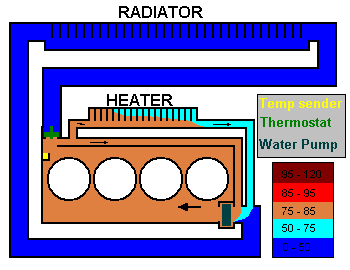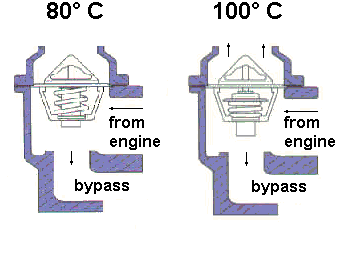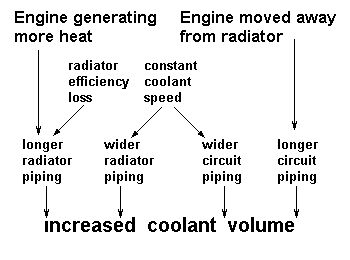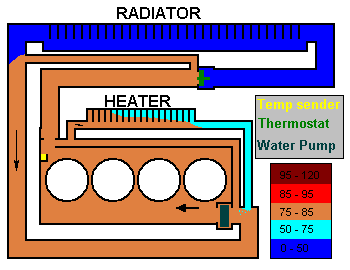
THE "CLASSIC" ENGINE:
CAST IRON BLOCK
The standard engine
The following drawing is of a simplified, generic engine, as most liquid cooled engines built in the past 50 years:

The engine is shown at 85° C at the thermostat (supposing it will start to open at 86°) There is a bypass circuit built in the engine and a parallel valved heater circuit. The pump is fed from the bypass, from the heater (if open) and from the main radiator return (with the stat open) and pushes it through all the engine towards the thermostat. The thermostat is at the engine outlet, close to the temp sender (in old engines the sender could also be found at the end of the radiator, as it switches only the cooling fan).

The success of this simple setup is based on the dampening/blending effect of the engine and bypass coolant. When the stat opens the cold coolant coming from the radiator mixes itself with the hot coolant contained in the engine and the bypass before getting in touch with the thermostat. The dampening effect of the engine protects the thermostat against sharp changes in temperature, allowing it to modulate the flow at its best. Although this setup has proven to be very reliable and is still used on many iron block engines nowadays, it nevertheless has to be balanced in its components.
Beyond the limits
The following part tries to explain what could happen on some heavily modified engines. Fitting a turbocharger is a good example, because it does greatly increase the amount of heat generated inside the engine. The extra heat needs to be transferred to the cooling system first, and to the air afterwards. There are various elements that determines the overall heat transfer from the engine to the coolant (coolant specs, surface and material of the coolant passageways inside the engine, etc.) but, as most are already optimized, the main way to improve the heat transfer is coolant gradient. Unfortunately the coolant is usually already kept near the highest safe temperature on the way out from the engine, so a bigger radiator, supplying cooler fluid to the engine, is often the only way to go. As the efficiency of the radiator suffers from a lower coolant exit temperature (being closer to air temp) the length of the radiator piping has to grow even more. Another aspect related to the new rad is the flow speed inside the engine. Assuming this factor has already been optimized, to prevent a significant loss in the heat transfer from the engine the flow should be kept at a similar level. Consequently, to keep a similar resistance to flow in the circuit, the bigger radiator has also to use wider pipes, increasing the coolant mass furthermore. If the placing of the engine is moved away from the radiator (as in a mid-engined car) the coolant mass is increased once more, firstly because of the longer piping and then, again, to maintain a good flow speed.

Assuming all the above components have been correctly dimensioned, the new system will be able to dismiss the extra heat generated by the engine at full power. Unfortunately the part of the cooling system left untouched may not be up to the job. The thermostat, as stated above, relies on the dampening/blending effect of the coolant contained in the engine/bypass to work properly. Once the mass outside the bypass is greatly increased, the amount of coolant inside the bypass circuit may not suffice to keep the thermostat away from quick temperature fluctuations. The coolant returning from the radiator is also colder to provide the higher gradient inside the engine, making things even worse. As a result the temperature of the coolant flowing at the thermostat may be out of sync with the engine needs: this means the thermostat may close when full flow is needed to cool the engine. The long reaction time of the thermostat (some seconds) will bring the engine to almost certain overheating, followed by a cool down at the stat opening, in a vicious cycle leading to possible engine destruction. A thermostat opening at lower temperature does reduce a bit the amplitude of the problem (balancing to a certain extent the colder water coming from the radiator), but the real solution is to increase the bypass volume (restoring the original proportion with the overall circuit). This approach has led to the successful fitting of a remote thermostat:
